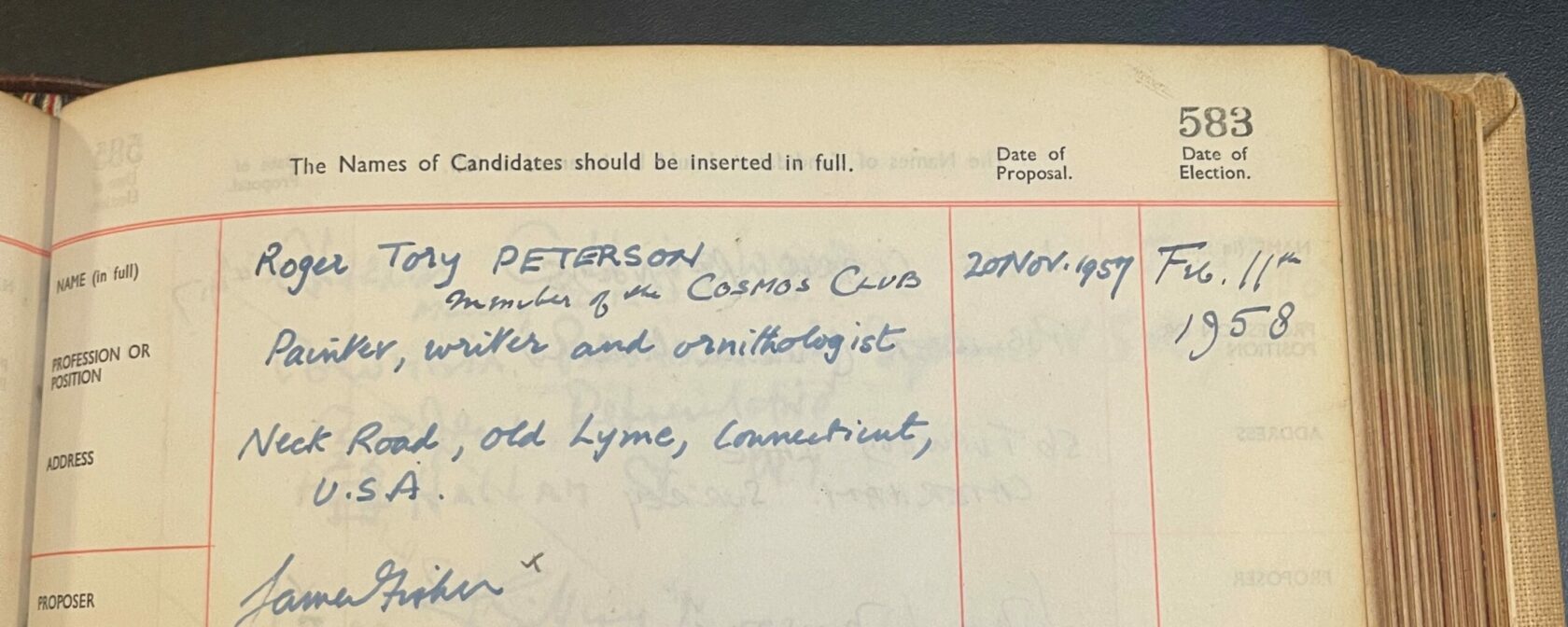
When an Archive Memo Leads to a London Gentlemen’s Club (and Lots and Lots of Birds)
In the archives at the Roger Tory Peterson Institute, there is a blue acid-free box; it’s just one of many on a long row of shelves in the archive room. In that box are tidy rows of files, and in each file is a sheaf of carbon-copy typewritten pages from the 1970s, each marked “memo”. One such page casually mentions a certain bird-lover’s trip to the United Kingdom, and his stay at the Savile Club. The Savile Club–located on Brook Street in Mayfair, London–is a prestigious gentlemen’s club established in 1868 by a group of the most distinguished writers and artists of the time. The who’s-who of Savile Club members includes Robert Louis Stevenson, H.G. Wells, A.A. Milne, and Rudyard Kipling, along with a dazzling array of actors, scientists, mathematicians, journalists, historians, gentry, and businessmen. In 1952, Roger Tory Peterson set up camp in that 18th-century house for eight months, where he and two other men–Phil Hollom and Guy Mountfort–drafted A Field Guide to the Birds of Britain and Europe (1954). While there, they enjoyed the company of 80-100 ornithological specimens from the British Museum, which Roger kept on the bookshelves in his rooms.
It is quite a picture to imagine an elegant room crammed with birds of all sizes, shapes, and colors, which probably had to be carefully reshuffled as Roger and his co-authors worked from species to species. Hollom designed the maps and Mountfort wrote the basic text, “except for those species (Roger) knew better.” Roger prepared all of the paintings, and also the legend pages.

Roger Tory Peterson (1908-1996), Cover Art from Birds of Britain and Europe 1993/
2001, gouache, Gift of the Estate of Roger Tory Peterson 2007.10.8.1 ©Estate of Roger Tory Peterson
Naturally, the Roger Tory Peterson Institute wanted to know more about this, but inquiring about events that happened seventy-one years ago can be tricky. We contacted both the British Museum and the Savile Club with fingers crossed, and quickly received a response from Club Secretary Julian Malone-Lee and Fiona Callaghan, Assistant Archivist of Collection Projects and Resources at British Museum. As it turns out, the institution which Roger Tory Peterson knew as the British Museum was no longer called the British Museum.
What we now know as the British Museum–the Greco-Roman structure with the candied almonds sold by winter street vendors on the outside and the Parthenon Marbles and Rosetta Stone on the inside–once housed natural history collections such as plants and animals. In 1881, those collections were transferred to the Natural History Museum a few boroughs away. The Natural History Museum is a massive, elegant structure of lovely brown stone, and is famous for its giant whale skeleton hanging in the atrium. Until 1992, its full name was the British Museum of Natural History. Roger visited in 1952–forty years before the name change. When Roger wrote the memo in the 1970s, anyone reading it at the time would have known exactly from which institution he had borrowed the birds. This archivist in 2023, however, needed to be told about this distinction (kindly) over email.
To add to the plot, the Savile Club–where Roger stayed with his co-authors and borrowed bird specimens–doubly responded. First came a reply that Roger Tory Peterson was elected a member to the Club on February 11, 1958, and remained a member until around 1971. He was proposed by British ornithologist and broadcaster James Fisher, the gentleman who incidentally also secured him the bird specimens. In 1953, James Fisher was Roger’s travel partner for a 3,000-mile journey around North America, and co-author of the ensuing book, Wild America (1956). According to Roger’s memo, “Normally, one had to do his research in the Museum and cannot take specimens out, but James apparently had a rare kind of clout in these matters.” Then a second, unexpected email came. Attached to it was a photograph of Roger’s entry in the Savile Club’s candidate book, which the staff at RTPI had never seen before:

Roger Tory Peterson’s admission log to the Savile Club. Courtesy of the Savile Club
“Show, don’t tell” is a famous nugget of writing advice, but it also translates to museums. Exhibitions are more engaging if objects are available to illustrate what is being said in the text panels. Put simply, people like to look at things. It is easier to relate to something when it’s sitting right in front of you, and not just a concept in your head. It was truly thrilling to see the ledger that directly illustrated the story from the memo, and also gave RTPI valuable information.
The search through the archives continues, and RTPI is excited to see what other stories it may hold.
